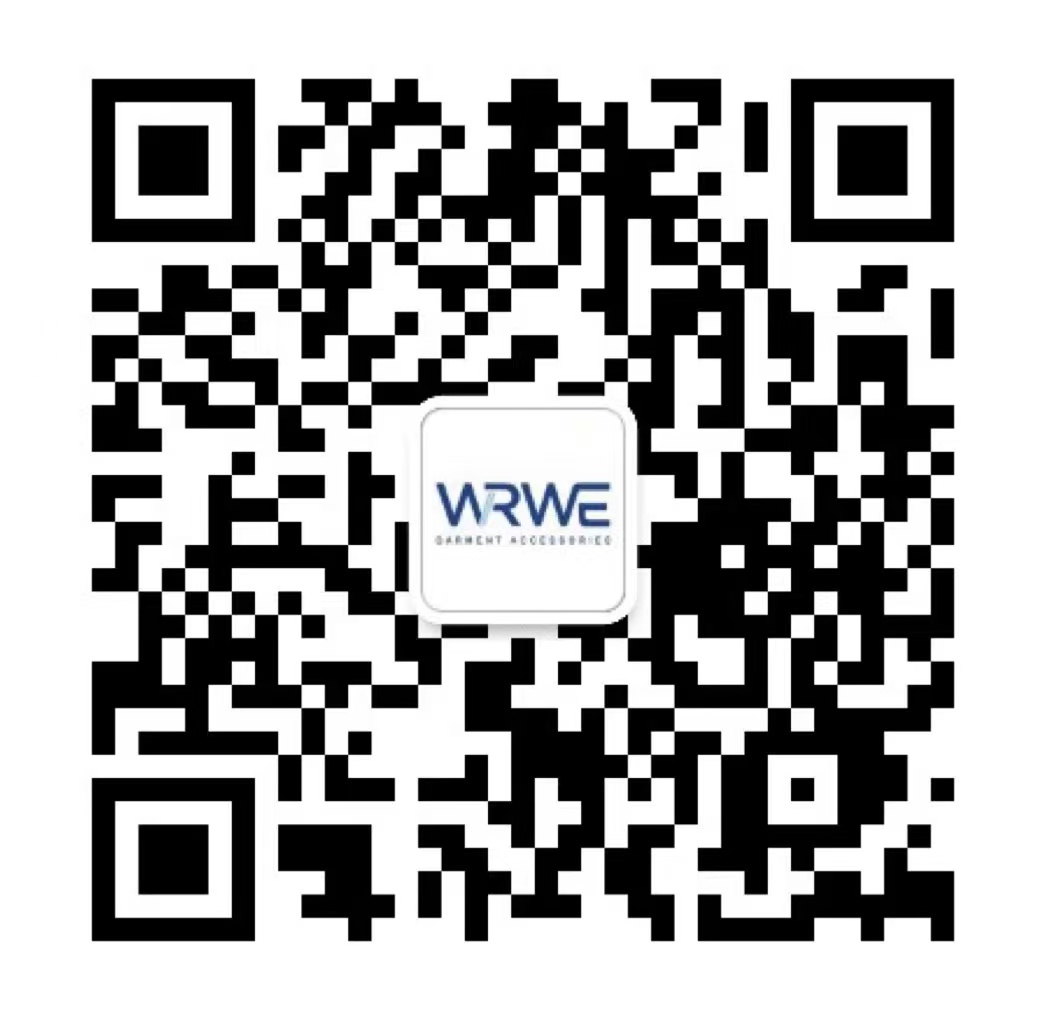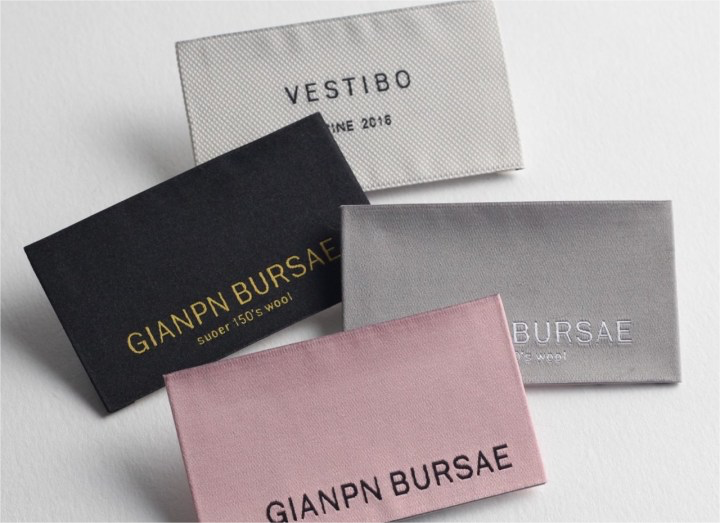
As someone engaged in the weaving label industry, it is necessary to understand what exactly a weaving label is. From the perspective of phrase composition, “woven label” is a compound word that can be understood as an abbreviation of “machine woven label”, while “label” is an oral term for “trademark” in Cantonese, originally translated as “mark” in English.
Due to the short period of time when woven label became the next independent sub industry of the textile industry, there is no authoritative or standard noun interpretation in the industry.
Weaving label, also known as fabric label, computer woven label. It can express brand name, logo, connotation, as well as product size, origin, ingredients, and instructions, so it is widely used in clothing, shoes and hats, luggage, and home textile products. The common woven logo trademarks include three categories: weft jacquard, warp jacquard, and woven before printed, with weft jacquard being the most commonly used.
Mainly used for collar labels or other clothing decorations. The process is similar to weaving, with the characteristic that the warp and weft yarns are generally black or white, and the patterns and text are composed of weft yarns. (If there is a special requirement to dye the warp yarn into the desired color, it is called the dyeing warp trademark.)
Trademark fabrics and ribbon fabrics have both similarities and significant differences. It has a narrower width like ribbon fabric, and its width range is larger than that of ribbon fabric. It also uses more text, letters, and small trademark patterns; However, due to the special purpose of the trademark, its fabric does not require a flat back and a certain degree of strength like ribbon fabrics.
Trademark fabrics are generally single weft, often with weft raised and raised. The raised weft thread often floats and sinks on the back of the fabric in areas without patterns, and some simply do not interweave with the fabric edge to save the weft thread. It is only fixed in a small number of positions. Trademark fabrics rarely use double-layer weave, and the floral part generally uses heavy weave.
Therefore, its weaving design requirements are lower than those of ribbon fabrics and ordinary fabrics. Therefore, trademark fabrics are more like ordinary fabrics, and their weaving process can be done using ordinary warp and weft systems. Computer aided design systems can also use ordinary weaving CAD and CAM systems.
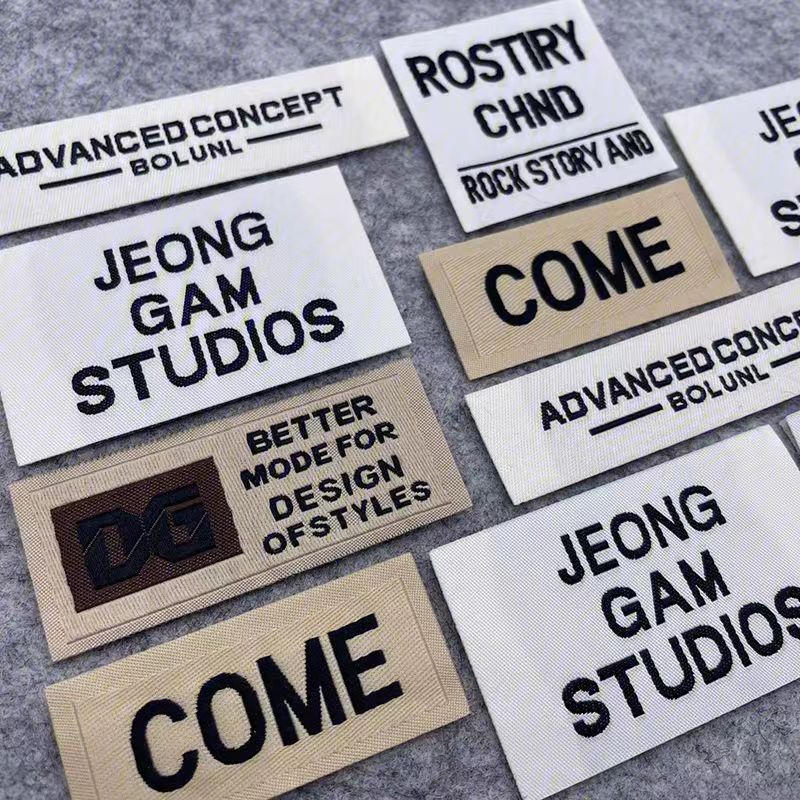
According to production technology, it is mainly divided into two types: woven edge and cut edge.
1.Weaving edge fabric label:When the required trademark is woven in one go according to the width requirements, it is called a woven edge trademark. This process avoids many drawbacks of edge cutting, but the yield is relatively low. There is also a distinction between flat and satin, characterized by a soft and firm texture.
It is more suitable for high-end clothing products, such as fashion, suits, etc., and is most commonly used by Japanese manufacturers who value quality. The machines are also made in Japan. Weaving edge markers are usually used for satin markers, but the satin background color is difficult to express. This problem is often solved by processes such as ironing/dyeing.
There are generally wooden shuttle machines for edge weaving, with the trademark of wooden shuttle machines (including Taiwan wooden shuttle machines and Japan wooden shuttle machines). After weaving from the machine, the trademark becomes a complete piece, so the edge is wrapped, and the weft yarn is of the same color from beginning to end, connected together, with a soft feel. Disadvantages: Low production efficiency, with only five or fewer colors available.
There is also a crochet machine, which has the same characteristics as the wooden shuttle machine trademark, but is not a shuttle machine, but a knitting machine, so the weft yarn is relatively tight and strong. It is commonly used as a hot stamping color code, utilizing the different characteristics of warp and weft yarns to transfer the bottom plate through high temperature printing and coloring. The trademark cost of this product type is relatively high.
The electronic jacquard trademark machine and the ribbon weaving machine can also weave various qualities of craftsmanship, and even add transparent polyester thread to the warp, known as the fish thread crochet machine.
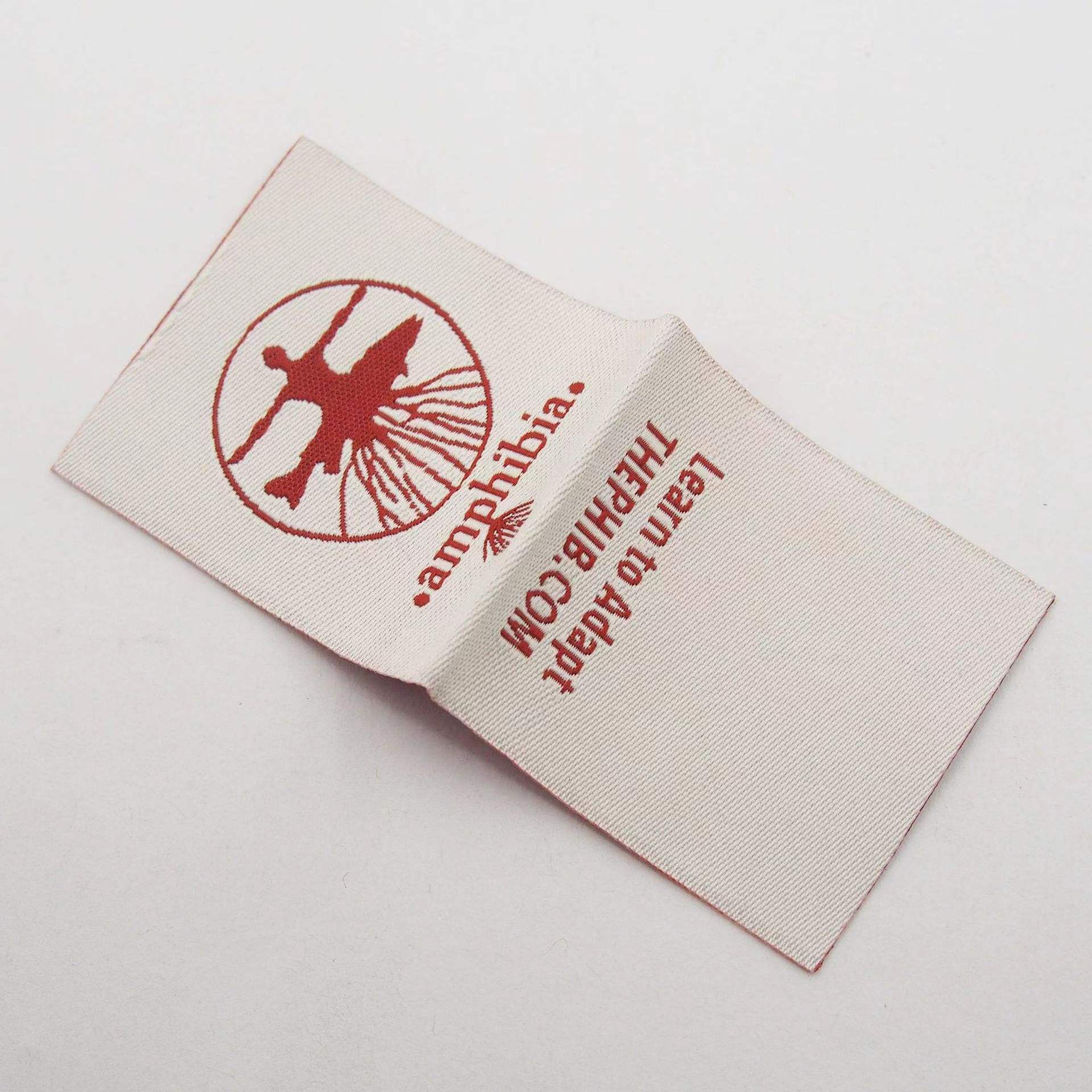
2.Trimmed fabric label: As the name suggests, on a specialized high-speed machine, a whole piece is woven like fabric, and then cut into strips according to the width of the label. Due to the thermal melting properties of polyester, the yarns will stick together during cutting and will not scatter. For this reason, the appearance and feel will be affected to a certain extent.
A good machine will be better, and using ultrasonic cutting will be better than ordinary electric knives. Striped fabric labels can be directly organized and sent to clothing factories for processing; If the requirements are strict, cutting and folding processing is still required. Because the maximum width of this machine is 20cm, which means it can weave labels of this width and process various shapes.
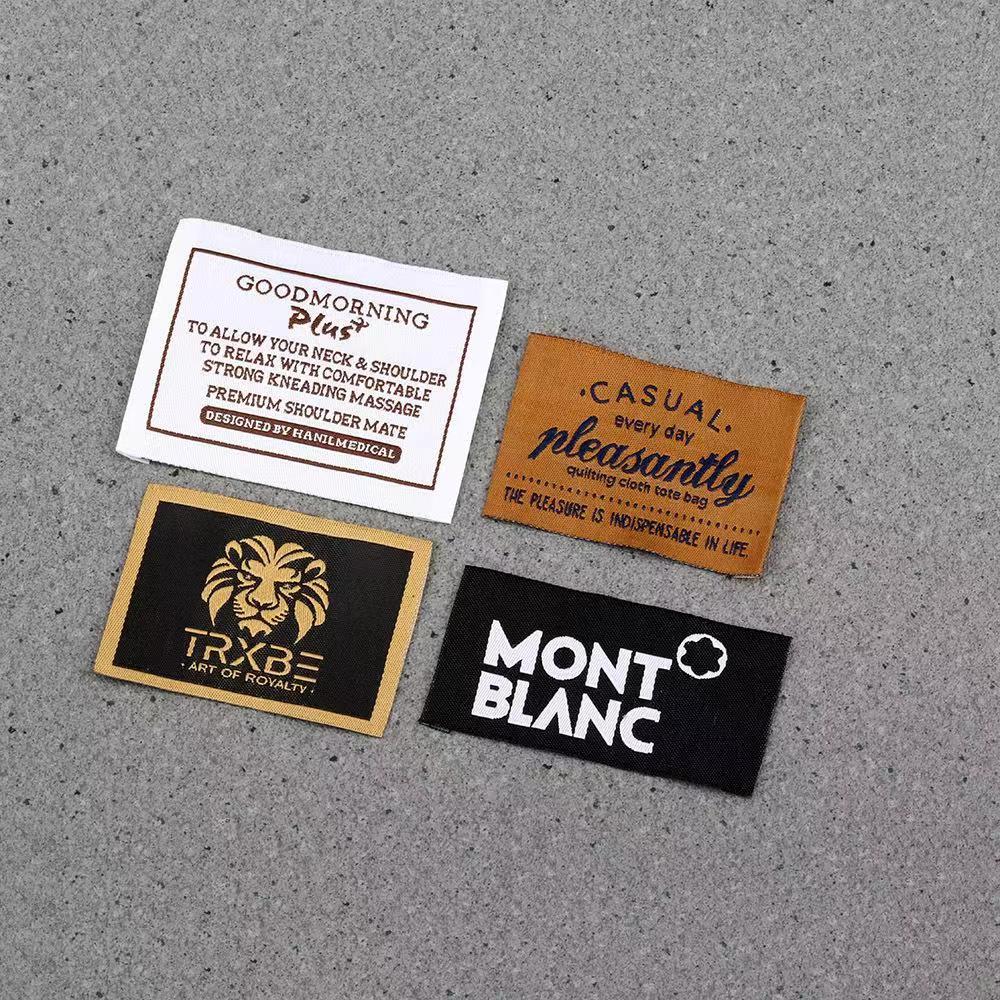
According to the classification of textile technology, it can be divided into two categories: flat label and satin label.
1.Flat label: A simple flat label is formed by interweaving one warp and one weft, resembling a fabric structure. Generally speaking, warp yarn.They are all fixed, either black or white, so there is a distinction between black and white. Light colored background colors are usually marked with white, while dark colored ones are generally used
Usually black flat is used. The pattern and color of fabric labels are mainly expressed by weft yarn, and the expressed color should be crossed with warp yarn.The effects are different and there are differences.
Due to the limitations of the types of weft yarns commonly used in machines, there are also colors that can be expressed.Restricted, generally within 8 types. (Our factory has newly introduced imported Huabao machines, which can reach 12 colors)
2.Satin label: The warp density is twice the plane elevation, and the twist of the warp is different. The warp is finer, so the woven fabric has a smooth and glossy texture.
The same warp yarn has a fixed color and is generally available in black/white, known as black satin or white satin. There are also special cases where warp yarns are dyed into other colors for weaving, and other parameters and processes are the same as those of flat labels.
As can be seen from the above, the price and cost components of woven labels include: the width of the fabric label, which is the amount of warp yarn used; The length of the fabric label and the longitudinal length of each color; Post process; Another factor is the variety of yarn used. JB series yarn is commonly used internationally, and the main domestic yarn supply currently includes YHG yarn from Huaigang, Jiangsu, and DAA yarn from Shantou, Guangdong.
There are also special requirements for using gold and silver yarn.In order to express details and colors more richly, double the weft used, which is called a double-sided label. If a certain sample color needs a more three-dimensional feeling, add another layer of yarn, which is called a heavy shuttle.
Except for washing and sizing, most use flat double-sided labels. The fabric labels are all made of yarn to express the pattern, which is definitely different from the original graphic design. Therefore, it is impossible to produce a large quantity without a small sample confirmation.
Other weaving marks, such as size marks, waist marks, main marks, side marks, flag marks, etc., are distinguished according to the purpose of the product.From this, it can be seen that there are various opinions on weaving marks.
Just the names that appear include weaving marks, silk weaving trademarks, fabric labels, trademark fabrics, trademark bands, and woven trademarks. Even its English translation can be divided into two types: Weaving LABEL and LABEL CLOTH. The reason is actually quite simple – it’s just a different angle.
The editor of Baidu entries should be a business personnel, who should provide a detailed introduction of their understanding of weaving marks to outsiders; Lianda Weaving (also known as Shura) explains weaving marks and the weaving mark industry from the perspective of designers.
